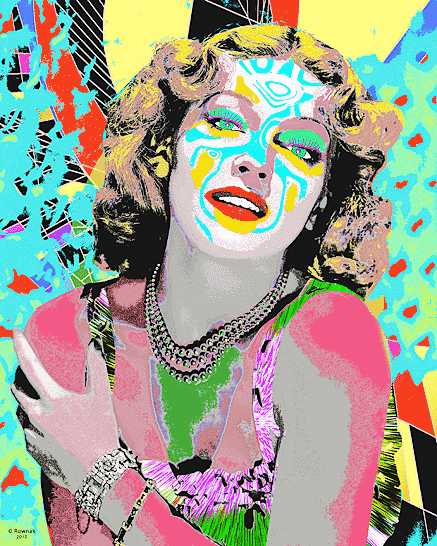
Want me to do a pop-art portrait for you? Send Send me an EMAIL and lets talk!
| Lana
Turner Biography orig. Julia Jean Mildred Frances Turner ( 1920 – 1921 ) Actress. Born Julia Jean Mildred Frances Turner, on February 8, 1921, in Wallace, Idaho. (Though Turner claimed in her autobiography that she was born in 1921, most sources agree on the earlier date.) One of America's most celebrated sex symbols during the 1940s and 1950s, Turner made over 50 films. Her tempestuous personal life -- seven marriages, a stable of lovers, and a very public murder scandal -- only increased her reputation as a larger-than-life screen and sex goddess. After her father, Virgil, a gambler and bootlegger, was murdered, the young Turner and her mother, Mildred, left the Idaho mining town of Wallace for San Francisco. In 1935, they moved again, this time to Los Angeles. While still a student at Hollywood High School, Turner was "discovered" by William R. Wilkerson, the publisher of the Hollywood Reporter, as she sat drinking a soda in the Top Hat Café (not Schwab's drugstore, as the famous Hollywood legend would have it). Wilkerson introduced Turner to Zeppo Marx (of the Marx Brothers), who owned his own casting agency, and Marx in turn sent her to the director Mervyn LeRoy. LeRoy cast the voluptuous 15-year-old actress (who chose the screen name "Lana" herself) in the thriller, They Won't Forget (1937), in which she appeared briefly but memorably in a form-fitting skirt and sweater. She soon signed a contract at the Metro-Goldwyn-Mayer studio. It was not long before Turner became known as the "Sweater Girl" -- the subject of a series of tremendously popular posters cherished by GI's around the world during World War II. Appearances in such films as The Great Garrick (1937), The Adventures of Marco Polo (1938), Love Finds Andy Hardy (1939), and These Glamour Girls (1939) only increased the potency of her sex symbol image. As her fame grew, she soon began winning leading roles, and in 1941 earned critical acclaim for her performance in Ziegfield Girl. In the next several years, Turner was cast opposite some of Hollywood's most prominent leading men, including Clark Gable (1941's Honky Tonk and 1942's Somewhere I'll Find You), Spencer Tracy (1941's Dr. Jekyll and Mr. Hyde), and Robert Taylor (1941’'s Johnny Eager). After World War II ended, Turner was able to move further away from the "Sweater Girl" moniker she hated. She gave one of her most respected performances as a cold-blooded adulteress in The Postman Always Rings Twice in 1946. After appearing in various other films, including Green Dolphin Street (1947), The Three Musketeers (1948), and The Bad and the Beautiful (1952), Turner took a risky move and left MGM, preferring to go out on her own. The move paid off, and in 1958 Turner garnered an Academy Award nomination for Best Actress for her role in Peyton Place. Throughout
her career, Turner's tempestuous personal life threatened to overshadow
her professional triumphs. Her first marriage, at age 20, to the bandleader
Artie Shaw, lasted less than six months. She married Stephen Crane,
a businessman, in 1942, only to find out that his divorce from his
first wife was not yet legal. They married again (this time legally)
in 1943, then divorced a year later, after Turner gave birth to a
daughter, Cheryl. In 1948, Turner married the multimillionaire Bob
Topping, but divorced him in 1951. She divorced her fourth husband,
Lex Barker, the onetime star of the Tarzan movies, in 1957, after
she learned that he had sexually abused the young Cheryl. She had
three more unsuccessful marriages -- to rancher Fred May, businessman
Robert Eaton, and nightclub hypnotist Ronald Dante -- and was rumored
to have many more lovers, including such luminaries as Frank Sinatra,
Richard Burton, Howard Hughes, Fernando Lamas, Dean Martin, Kirk Douglas,
and Tyrone Power. In the years that followed, however, Turner seemed to have been relegated to second-tier films and television productions. In the 1970s, she toured with several stage productions, and in 1982 she began appearing on the hit TV series, Falcon Crest, opposite Jane Wyman. She published her autobiography, Lana: The Lady, The Legend, The Truth, in 1982. A year later, Turner officially retired from acting. In 1981, Turner reconciled with her daughter Cheryl, who overcame continuing emotional problems (including a 10-month stay in a mental hospital at age 17) to become a successful businesswoman. Turner lived quietly and stayed out of the public eye until 1992, when rumors began to spread that the actress, a longtime heavy smoker, was undergoing treatment for throat cancer. On June 29, at age 75, Turner died at her home in Century City, Los Angeles, with her daughter at her side.
|
